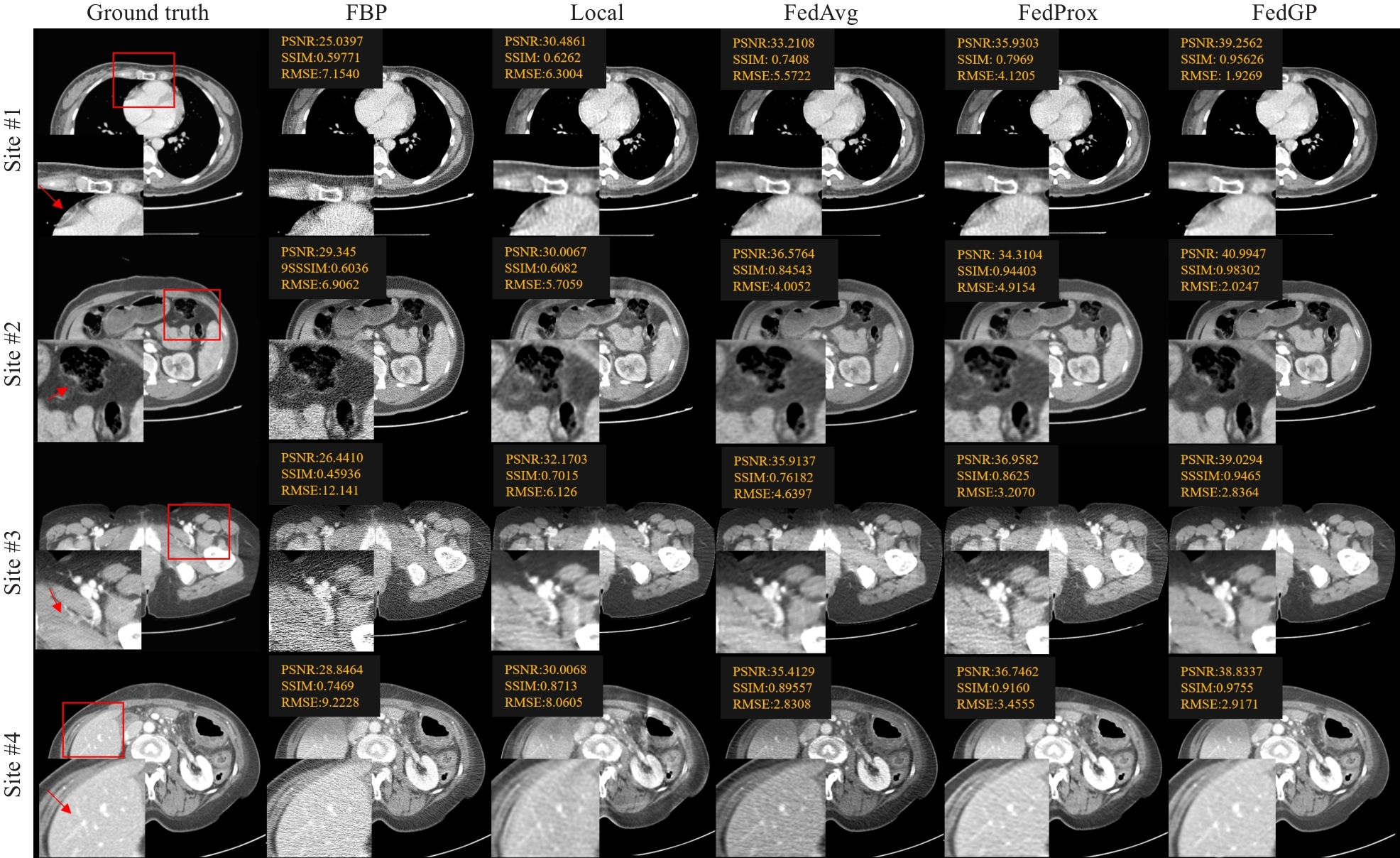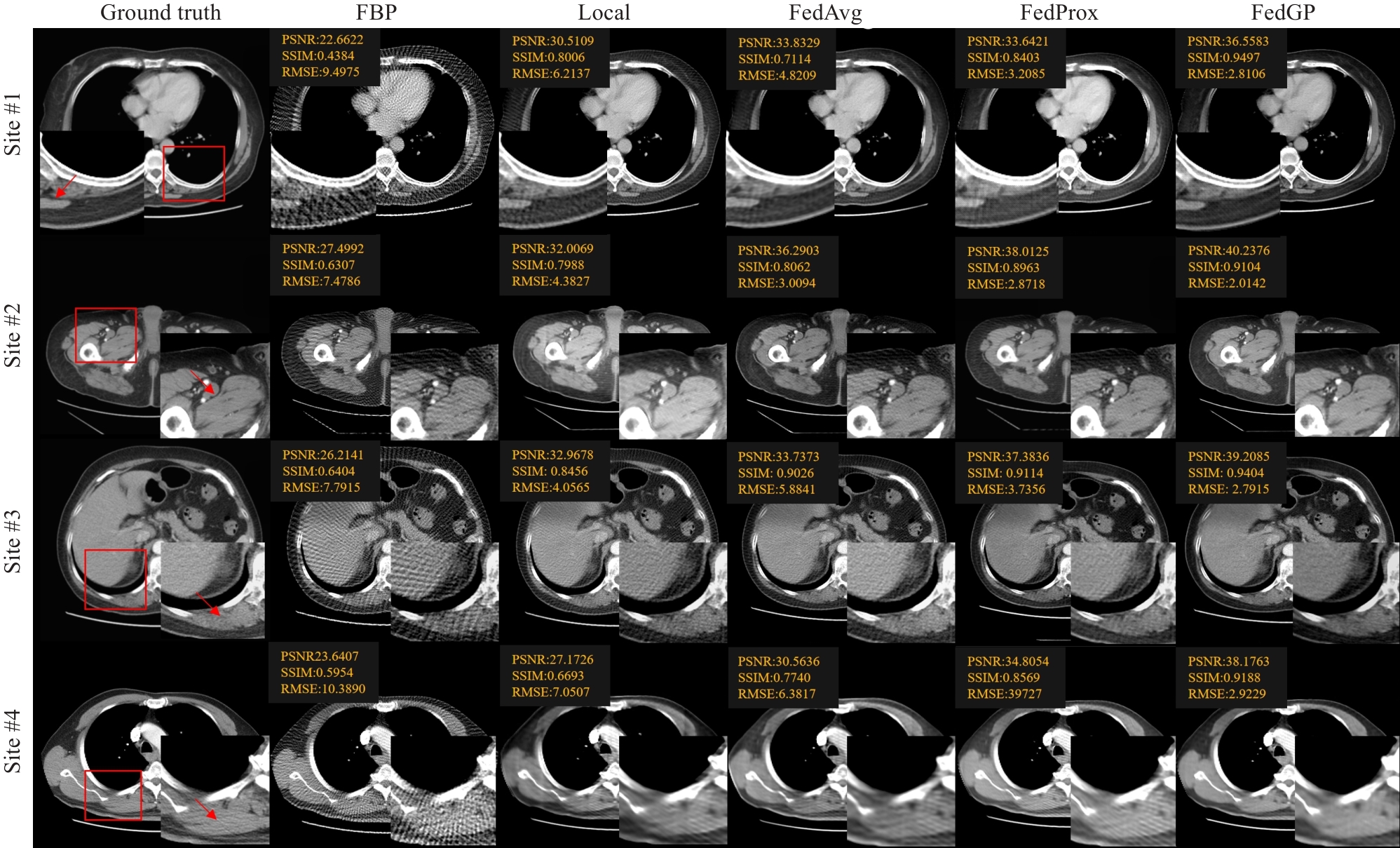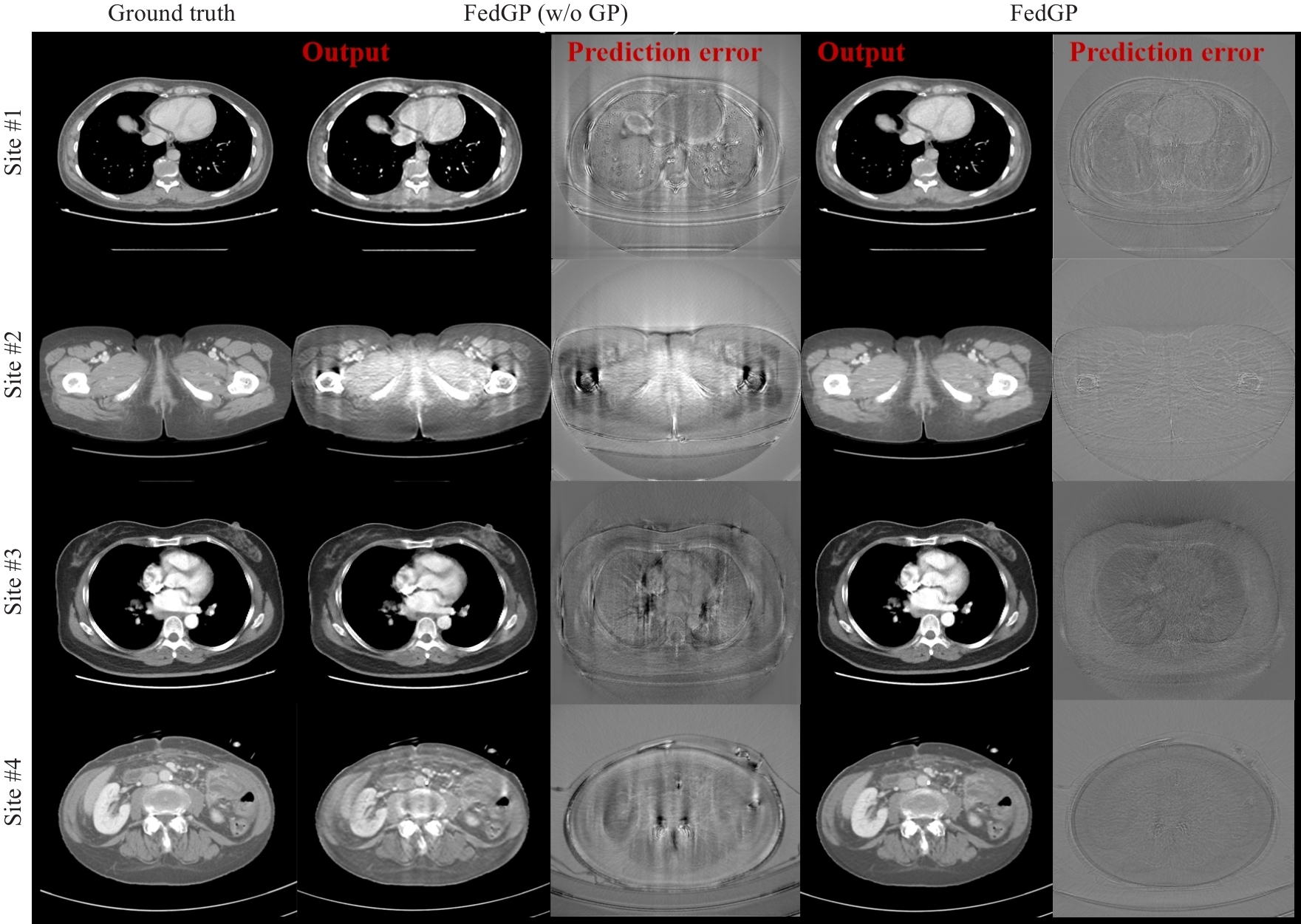Journal of Southern Medical University ›› 2025, Vol. 45 ›› Issue (4): 844-852.doi: 10.12122/j.issn.1673-4254.2025.04.20
Xiaoyu ZHANG( ), Hao WANG, Dong ZENG, Zhaoying BIAN(
), Hao WANG, Dong ZENG, Zhaoying BIAN( )
)
Received:2024-11-14
Online:2025-04-20
Published:2025-04-28
Contact:
Zhaoying BIAN
E-mail:zxy4118050022@smu.edu.cn;zybian@smu.edu.cn
Supported by:Xiaoyu ZHANG, Hao WANG, Dong ZENG, Zhaoying BIAN. A low-dose CT image restoration method based on central guidance and alternating optimization[J]. Journal of Southern Medical University, 2025, 45(4): 844-852.
Add to citation manager EndNote|Ris|BibTeX
URL: https://www.j-smu.com/EN/10.12122/j.issn.1673-4254.2025.04.20
| Simulation parameter | Site #1 | Site #2 | Site #3 | Site #4 |
|---|---|---|---|---|
| Number of projection views | 896 | 512 | 768 | 896 |
| Number of detector bins | 1008 | 1024 | 904 | 1008 |
| Length of a detector bin (mm) | 0.5480 | 0.6500 | 0.6000 | 0.5480 |
| Length of a voxel (mm) | 0.7421 | 0.7500 | 0.7000 | 0.7421 |
| DSD (mm) | 800.0 | 750.1 | 946.7 | 800.0 |
| DSO (mm) | 550.0 | 476.8 | 538.5 | 550.0 |
| Condition 1:Dose level (X-ray intensities) | 1×105 | 3×105 | 1×105 | 3×105 |
| Condition 2:Sampling scale | 8 | 6 | 6 | 8 |
Tab.1 Experimental simulation parameters for each site dataset
| Simulation parameter | Site #1 | Site #2 | Site #3 | Site #4 |
|---|---|---|---|---|
| Number of projection views | 896 | 512 | 768 | 896 |
| Number of detector bins | 1008 | 1024 | 904 | 1008 |
| Length of a detector bin (mm) | 0.5480 | 0.6500 | 0.6000 | 0.5480 |
| Length of a voxel (mm) | 0.7421 | 0.7500 | 0.7000 | 0.7421 |
| DSD (mm) | 800.0 | 750.1 | 946.7 | 800.0 |
| DSO (mm) | 550.0 | 476.8 | 538.5 | 550.0 |
| Condition 1:Dose level (X-ray intensities) | 1×105 | 3×105 | 1×105 | 3×105 |
| Condition 2:Sampling scale | 8 | 6 | 6 | 8 |

Fig.2 Representative images and ROIs for site 1-4 in the low-dose CT experiment generated by FedGP and other methods (results of site 1-4 shows window [-200, 200]).
| Site | Method | PSNR | SSIM | RMSE |
|---|---|---|---|---|
Site #1 | FBP | 26.203±1.134 | 0.532±0.092 | 8.372±1.496 |
| Local | 30.812±2.512 | 0.702±0.123 | 6.712±1.824 | |
| FedAvg | 33.024±3.114 | 0.785±0.095 | 6.348±1.251 | |
| FedProx | 34.553±2.127 | 0.822±0.071 | 5.945±1.915 | |
| FedGP | 39.870±2.206 | 0.957±0.022 | 2.815±0.731 | |
Site #2 | FBP | 29.305±1.452 | 0.612±0.079 | 6.215±1.372 |
| Local | 32.100±3.421 | 0.715±0.125 | 5.214±2.067 | |
| FedAvg | 36.420±3.985 | 0.891±0.042 | 5.118±1.718 | |
| FedProx | 35.100±3.530 | 0.854±0.136 | 4.571±2.120 | |
| FedGP | 41.450±1.893 | 0.946±0.029 | 2.425±0.581 | |
Site #3 | FBP | 26.912±0.852 | 0.482±0.134 | 12.791±1.936 |
| Local | 31.702±2.634 | 0.659±0.112 | 7.142±2.025 | |
| FedAvg | 35.510±3.178 | 0.703±0.109 | 4.512±1.614 | |
| FedProx | 34.510±3.170 | 0.799±0.105 | 4.194±1.850 | |
| FedGP | 39.925±1.951 | 0.923±0.046 | 2.105±0.842 | |
Site #4 | FBP | 28.510±1.528 | 0.732±0.118 | 10.051±1.925 |
| Local | 30.582±3.282 | 0.775±0.097 | 8.832±1.153 | |
| FedAvg | 36.112±3.024 | 0.815±0.093 | 3.785±1.831 | |
| FedProx | 35.821±3.965 | 0.902±0.052 | 3.275±2.162 | |
| FedGP | 39.752±2.742 | 0.960±0.029 | 2.217±1.358 |
Tab.2 Quantitative metrics of site 1-4 on the multi-institutional low-mAs CT experimental test set (Mean±SD)
| Site | Method | PSNR | SSIM | RMSE |
|---|---|---|---|---|
Site #1 | FBP | 26.203±1.134 | 0.532±0.092 | 8.372±1.496 |
| Local | 30.812±2.512 | 0.702±0.123 | 6.712±1.824 | |
| FedAvg | 33.024±3.114 | 0.785±0.095 | 6.348±1.251 | |
| FedProx | 34.553±2.127 | 0.822±0.071 | 5.945±1.915 | |
| FedGP | 39.870±2.206 | 0.957±0.022 | 2.815±0.731 | |
Site #2 | FBP | 29.305±1.452 | 0.612±0.079 | 6.215±1.372 |
| Local | 32.100±3.421 | 0.715±0.125 | 5.214±2.067 | |
| FedAvg | 36.420±3.985 | 0.891±0.042 | 5.118±1.718 | |
| FedProx | 35.100±3.530 | 0.854±0.136 | 4.571±2.120 | |
| FedGP | 41.450±1.893 | 0.946±0.029 | 2.425±0.581 | |
Site #3 | FBP | 26.912±0.852 | 0.482±0.134 | 12.791±1.936 |
| Local | 31.702±2.634 | 0.659±0.112 | 7.142±2.025 | |
| FedAvg | 35.510±3.178 | 0.703±0.109 | 4.512±1.614 | |
| FedProx | 34.510±3.170 | 0.799±0.105 | 4.194±1.850 | |
| FedGP | 39.925±1.951 | 0.923±0.046 | 2.105±0.842 | |
Site #4 | FBP | 28.510±1.528 | 0.732±0.118 | 10.051±1.925 |
| Local | 30.582±3.282 | 0.775±0.097 | 8.832±1.153 | |
| FedAvg | 36.112±3.024 | 0.815±0.093 | 3.785±1.831 | |
| FedProx | 35.821±3.965 | 0.902±0.052 | 3.275±2.162 | |
| FedGP | 39.752±2.742 | 0.960±0.029 | 2.217±1.358 |

Fig.3 Representative images and ROIs for site 1-4 in the sparse-view CT experiment generated by FedGP and other methods (results of site 1-4 shows window [-200, 200]).
| Site | Method | PSNR | SSIM | RMSE |
|---|---|---|---|---|
Site #1 | FBP | 24.500±4.462 | 0.586±0.073 | 9.542±3.983 |
| Local | 30.655±2.582 | 0.713±0.119 | 6.823±1.479 | |
| FedAvg | 32.812±3.014 | 0.820±0.156 | 5.017±1.633 | |
| FedProx | 33.875±3.227 | 0.818±0.115 | 4.194±1.850 | |
| FedGP | 37.990±1.788 | 0.918±0.041 | 2.682±0.732 | |
Site #2 | FBP | 27.765±1.295 | 0.705±0.109 | 8.985±2.267 |
| Local | 31.980±2.756 | 0.728±0.084 | 5.372±1.846 | |
| FedAvg | 35.230±2.252 | 0.834±0.128 | 4.282±1.552 | |
| FedProx | 37.645±2.918 | 0.869±0.051 | 3.026±0.742 | |
| FedGP | 40.320±1.625 | 0.930±0.038 | 2.315±0.625 | |
Site #3 | FBP | 28.674±3.741 | 0.658±0.105 | 7.459±2.330 |
| Local | 31.185±2.790 | 0.769±0.094 | 5.372±1.905 | |
| FedAvg | 33.295±2.180 | 0.845±0.042 | 4.573±1.637 | |
| FedProx | 36.380±2.093 | 0.870±0.055 | 3.960±1.553 | |
| FedGP | 39.186±1.587 | 0.928±0.042 | 2.778±0.751 | |
Site #4 | FBP | 22.984±4.181 | 0.572±0.136 | 11.195±3.780 |
| Local | 27.290±3.475 | 0.688±0.120 | 7.291±1.955 | |
| FedAvg | 32.547±2.226 | 0.752±0.096 | 6.062±1.434 | |
| FedProx | 33.785±1.589 | 0.820±0.075 | 3.493±1.092 | |
| FedGP | 37.868±1.077 | 0.915±0.040 | 2.477±0.311 |
Tab.3 Quantitative metrics results of Site 1-4 on the multi-institutional sparse-view CT experimental test set (Mean±SD)
| Site | Method | PSNR | SSIM | RMSE |
|---|---|---|---|---|
Site #1 | FBP | 24.500±4.462 | 0.586±0.073 | 9.542±3.983 |
| Local | 30.655±2.582 | 0.713±0.119 | 6.823±1.479 | |
| FedAvg | 32.812±3.014 | 0.820±0.156 | 5.017±1.633 | |
| FedProx | 33.875±3.227 | 0.818±0.115 | 4.194±1.850 | |
| FedGP | 37.990±1.788 | 0.918±0.041 | 2.682±0.732 | |
Site #2 | FBP | 27.765±1.295 | 0.705±0.109 | 8.985±2.267 |
| Local | 31.980±2.756 | 0.728±0.084 | 5.372±1.846 | |
| FedAvg | 35.230±2.252 | 0.834±0.128 | 4.282±1.552 | |
| FedProx | 37.645±2.918 | 0.869±0.051 | 3.026±0.742 | |
| FedGP | 40.320±1.625 | 0.930±0.038 | 2.315±0.625 | |
Site #3 | FBP | 28.674±3.741 | 0.658±0.105 | 7.459±2.330 |
| Local | 31.185±2.790 | 0.769±0.094 | 5.372±1.905 | |
| FedAvg | 33.295±2.180 | 0.845±0.042 | 4.573±1.637 | |
| FedProx | 36.380±2.093 | 0.870±0.055 | 3.960±1.553 | |
| FedGP | 39.186±1.587 | 0.928±0.042 | 2.778±0.751 | |
Site #4 | FBP | 22.984±4.181 | 0.572±0.136 | 11.195±3.780 |
| Local | 27.290±3.475 | 0.688±0.120 | 7.291±1.955 | |
| FedAvg | 32.547±2.226 | 0.752±0.096 | 6.062±1.434 | |
| FedProx | 33.785±1.589 | 0.820±0.075 | 3.493±1.092 | |
| FedGP | 37.868±1.077 | 0.915±0.040 | 2.477±0.311 |

Fig.4 Representative reconstruction results and prediction errors of FedGP and FedGP (w/o GP) in the low-mAs CT reconstruction experiment (results of Site 1-4 shows window [-160, 240]).
| 1 | Berrington de González A, Darby S. Risk of cancer from diagnostic X-rays: estimates for the UK and 14 other countries[J]. Lancet, 2004, 363(9406): 345-51. |
| 2 | Brenner DJ, Hall EJ. Computed tomography: an increasing source of radiation exposure[J]. N Engl J Med, 2007, 357(22): 2277-84. |
| 3 | Murase K, Nanjo T, Ii S, et al. Effect of X-ray tube current on the accuracy of cerebral perfusion parameters obtained by CT perfusion studies[J]. Phys Med Biol, 2005, 50(21): 5019-29. |
| 4 | Meng MQ, Wang YB, Zhu MM, et al. Dual-task learning for low-dose CT simulation and denoising[C]//7th International Conference on Image Formation in X-Ray Computed Tomography. June 12-16, 2022. Baltimore, USA. SPIE, 2022: 602-607. |
| 5 | Li DY, Bian ZY, Li S, et al. Noise characteristics modeled unsupervised network for robust CT image reconstruction[J]. IEEE Trans Med Imaging, 2022, 41(12): 3849-61. |
| 6 | You CY, Li G, Zhang Y, et al. CT super-resolution GAN constrained by the identical, residual, and cycle learning ensemble (GAN-CIRCLE)[J]. IEEE Trans Med Imaging, 2020, 39(1): 188-203. |
| 7 | He J, Wang YB, Ma JH. Radon inversion via deep learning[J]. IEEE Trans Med Imaging, 2020, 39(6): 2076-87. |
| 8 | Xia WJ, Lu ZX, Huang YQ, et al. MAGIC: manifold and graph integrative convolutional network for low-dose CT reconstruction[J]. IEEE Trans Med Imag, 2021, 40(12): 3459-72. |
| 9 | Han Y, Ye JC. Framing U-Net via deep convolutional framelets: application to sparse-view CT[J]. IEEE Trans Med Imaging, 2018, 37(6): 1418-29. |
| 10 | Kim B, Shim H, Baek J. A streak artifact reduction algorithm in sparse-view CT using a self-supervised neural representation[J]. Med Phys, 2022, 49(12): 7497-515. |
| 11 | Lee M, Kim H, Kim HJ. Sparse-view CT reconstruction based on multi-level wavelet convolution neural network[J]. Phys Med, 2020, 80: 352-62. |
| 12 | Voigt P, von dem Bussche A. The EU general data protection regulation (GDPR): a practical guide[M]. Cham, Switzerland: Springer International Publishing, 2017. |
| 13 | Sheller MJ, Edwards B, Anthony Reina G, et al. Federated learning in medicine: facilitating multi-institutional collaborations without sharing patient data[J]. Sci Rep, 2020, 10(1): 12598. |
| 14 | Fallah A, Mokhtari A, Ozdaglar A. Personalized federated learning: a meta-learning approach[EB/OL]. 2020: 2002.07948. . |
| 15 | Li T, Sahu AK, Talwalkar A, et al. Federated learning: challenges, methods, and future directions[J]. IEEE Signal Process Mag, 2020, 37(3): 50-60. |
| 16 | McMahan HB, Moore E, Ramage D, et al. Communication-efficient learning of deep networks from decentralized data[EB/OL]. 2016: 1602.05629. . |
| 17 | Yang ZY, Xia WJ, Lu ZX, et al. Hypernetwork-based personalized federated learning for multi-institutional CT imaging[EB/OL]. 2022: 2206.03709. . |
| 18 | 陈世宣, 曾 栋, 边兆英, 等. 基于联邦特征学习的多机型低剂量CT重建算法[J]. 南方医科大学学报, 2024, 44(2): 333-43. |
| 19 | Solanes A, Palau P, Fortea L, et al. Biased accuracy in multisite machine-learning studies due to incomplete removal of the effects of the site[J]. Psychiatry Res Neuroimaging, 2021, 314: 111313. |
| 20 | Perez E, Strub F, De Vries H, et al. FiLM: visual reasoning with a general conditioning layer[J]. Proc AAAI Conf Artif Intell, 2018, 32(1): 3942-51. |
| 21 | Albarqouni S, Bakas S, Kamnitsas K, et al. Domain adaptation and representation transfer, and distributed and collaborative learning: second MICCAI Workshop, DART 2020, and first MICCAI Workshop, DCL 2020, held in conjunction with MICCAI 2020, Lima, Peru, October 4-8, 2020 , Proceedings[M]. Cham, Switzerland: Springer, 2020. |
| 22 | Zhu HY, Xu JJ, Liu SQ, et al. Federated learning on non-IID data: a survey[J]. Neurocomputing, 2021, 465: 371-90. |
| 23 | Li XX, Jiang MR, Zhang XF, et al. FedBN: federated learning on non-IID features via local batch normalization[EB/OL]. 2021: 2102.07623. . |
| 24 | McCollough C. TU-FG-207A-04: overview of the low dose CT grand challenge[J]. Med Phys, 2016, 43(6Part35): 3759-60. |
| 25 | Moen TR, Chen BY, et al. Low-dose CT image and projection dataset[J]. Med Phys, 2021, 48(2): 902-11. |
| 26 | Ma J, Zhang Y, Gu S, et al. AbdomenCT-1K: is abdominal organ segmentation a solved problem[J]? IEEE Trans Pattern Anal Mach Intell, 2022, 44(10): 6695-714. |
| 27 | Deng Y, Wang C, Hui Y, et al. CTSpine 1K: a large-scale dataset for spinal vertebrae segmentation in computed tomography[EB/OL]. 2021: 2105.14711. . |
| 28 | van Aarle W, Palenstijn WJ, Cant J, et al. Fast and flexible X-ray tomography using the ASTRA toolbox[J]. Opt Express, 2016, 24(22): 25129-47. |
| 29 | Zeng D, Huang J, Bian ZY, et al. A simple low-dose X-ray CT simulation from high-dose scan[J]. IEEE Trans Nucl Sci, 2015, 62(5): 2226-33. |
| 30 | Hinton G, Van Der Maaten L. Visualizing data using t-sne journal of machine learning research[J]. Jf Mach Learn Res, 2008, 9: 2579-605. |
| 31 | Li T, Sahu AK, Zaheer M, et al. Federated optimization in heterogeneous networks[J]. Proceed Mach Learn Sys, 2020, 2: 429-50. |
| [1] | Zhixiong ZENG, Yongbo WANG, Zongyue LIN, Zhaoying BIAN, Jianhua MA. A segmented backprojection tensor degradation feature encoding model for motion artifacts correction in dental cone beam computed tomography [J]. Journal of Southern Medical University, 2025, 45(2): 422-436. |
| [2] | Shizhou TANG, Ruolan SU, Shuting LI, Zhenzhen LAI, Jinhong HUANG, Shanzhou NIU. A low-dose CT reconstruction method using sub-pixel anisotropic diffusion [J]. Journal of Southern Medical University, 2025, 45(1): 162-169. |
| [3] | Shengwang PENG, Yongbo WANG, Zhaoying BIAN, Jianhua MA, Jing HUANG. A dual-domain cone beam computed tomography reconstruction framework with improved differentiable domain transform for cone-angle artifact correction [J]. Journal of Southern Medical University, 2024, 44(6): 1188-1197. |
| [4] | Zongyue LIN, Yongbo WANG, Zhaoying BIAN, Jianhua MA. A deep blur learning-based motion artifact reduction algorithm for dental cone-beam computed tomography images [J]. Journal of Southern Medical University, 2024, 44(6): 1198-1208. |
| [5] | CHEN Shixuan, ZENG Dong, BIAN Zhaoying, MA Jianhua. A low-dose CT reconstruction algorithm across different scanners based on federated feature learning [J]. Journal of Southern Medical University, 2024, 44(2): 333-343. |
| [6] | ZHONG Weixiong, LIANG Fangrong, YANG Ruimeng, ZHEN Xin. Prediction of microvascular invasion in hepatocellular carcinoma based on multi-phase dynamic enhanced CT radiomics feature and multi-classifier hierarchical fusion model [J]. Journal of Southern Medical University, 2024, 44(2): 260-269. |
| [7] | Caolin LIU, Qingqing ZOU, Menghong WANG, Qinmei YANG, Liwen SONG, Zixiao LU, Qianjin FENG, Yinghua ZHAO. Identification of osteoid and chondroid matrix mineralization in primary bone tumors using a deep learning fusion model based on CT and clinical features: a multi-center retrospective study [J]. Journal of Southern Medical University, 2024, 44(12): 2412-2420. |
| [8] | Jingyi LIAO, Shengwang PENG, Yongbo WANG, Zhaoying BIAN. A dual-domain cone beam computed tomography sparse-view reconstruction method based on generative projection interpolation [J]. Journal of Southern Medical University, 2024, 44(10): 2044-2054. |
| [9] | ZHOU Hao, ZENG Dong, BIAN Zhaoying, MA Jianhua. A semi-supervised network-based tissue-aware contrast enhancement method for CT images [J]. Journal of Southern Medical University, 2023, 43(6): 985-993. |
| [10] | WANG Weiran, SUN Zeyu, XIN Ran, DING Yipu, LIU Zinuan, WANG Xi, WANG Jing, SHAN Dongkai, LIU Changfu. Calcification distributional density of the aortic-valvular complex is an independent risk factor for conduction block following self-expanding transcatheter aortic valve replacement [J]. Journal of Southern Medical University, 2023, 43(11): 1901-1908. |
| [11] | NIU Shanzhou, LIU Hong, LIU Peiyun, ZHANG Mengzhen, LI Shuo, LIANG Lijing, LI Nan, LIU Guoliang. Nonlocal low-rank and sparse matrix decomposition for low-dose cerebral perfusion CT image restoration [J]. Journal of Southern Medical University, 2022, 42(9): 1309-1316. |
| [12] | HE Fawei, WANG Yongbo, TAO Xi, ZHU Manman, HONG Zixuan, BIAN Zhaoying, MA Jianhua. Low-dose helical CT projection data restoration using noise estimation [J]. Journal of Southern Medical University, 2022, 42(6): 849-859. |
| [13] | LIU Changfu, SUN Zeyu, WANG Jing, WANG Minhan, XIN Ran, DING Yipu, WANG Xi, MU Yang, CHEN Tao, JIANG Bo, WANG Lin, ZHANG Ming, SHAN Dongkai, CHEN Yundai. Anythink for CT-based aorta root measurements before transcatheter aortic valve replacement: measurement consistency with 3mensio and impact on short-term prognosis [J]. Journal of Southern Medical University, 2022, 42(11): 1646-1654. |
| [14] | . CT image quality assessment based on prior information of pre-restored images [J]. Journal of Southern Medical University, 2021, 41(2): 230-237. |
| [15] |
.
Four-dimensional cone-beam CT reconstruction based on motion-compensated robust principal component analysis
[J]. Journal of Southern Medical University, 2021, 41(2): 243-249.
|
| Viewed | ||||||
|
Full text |
|
|||||
|
Abstract |
|
|||||